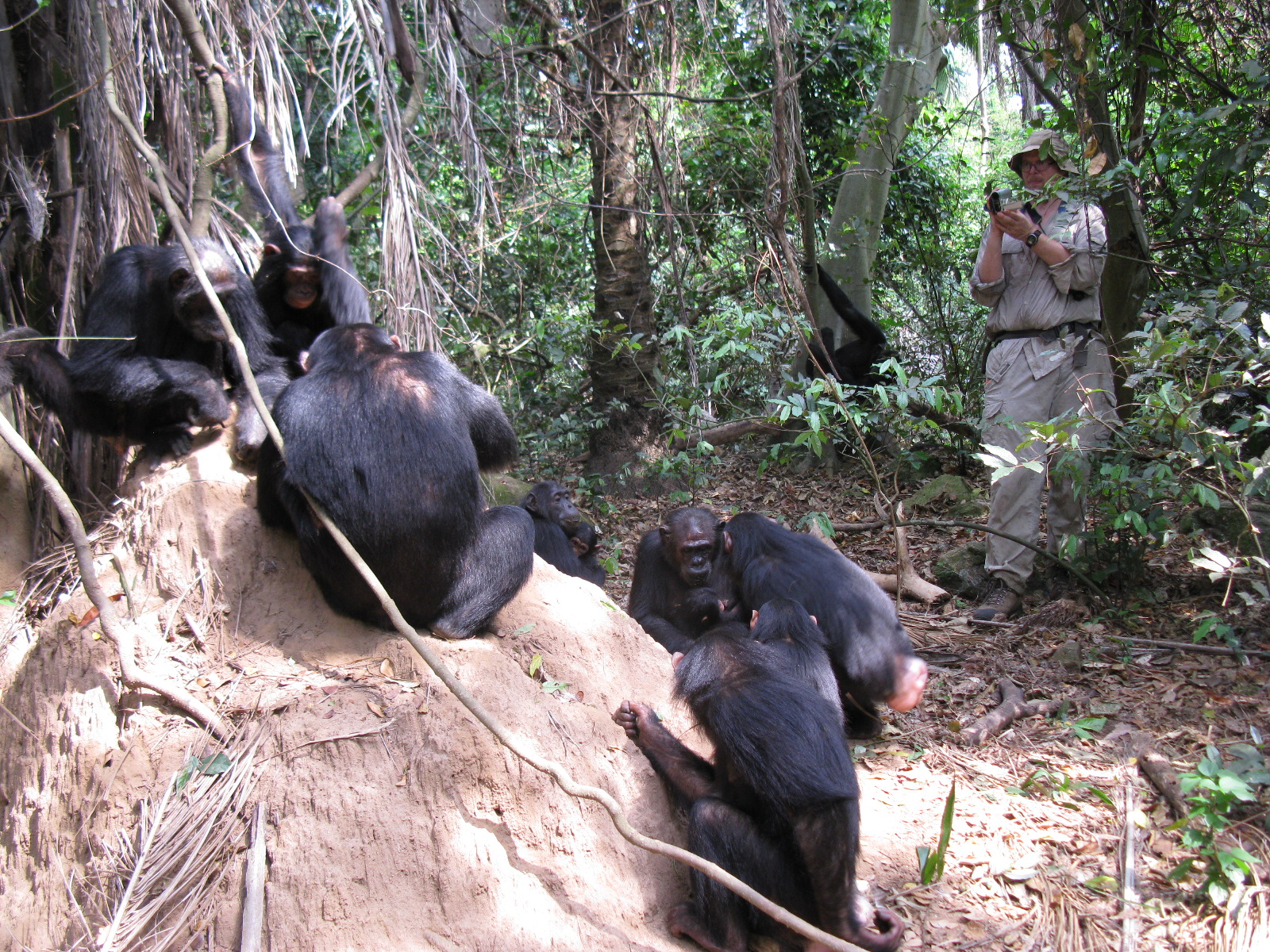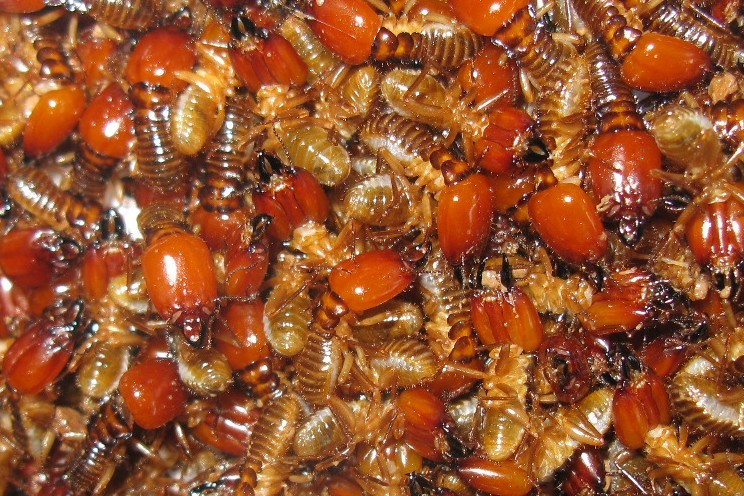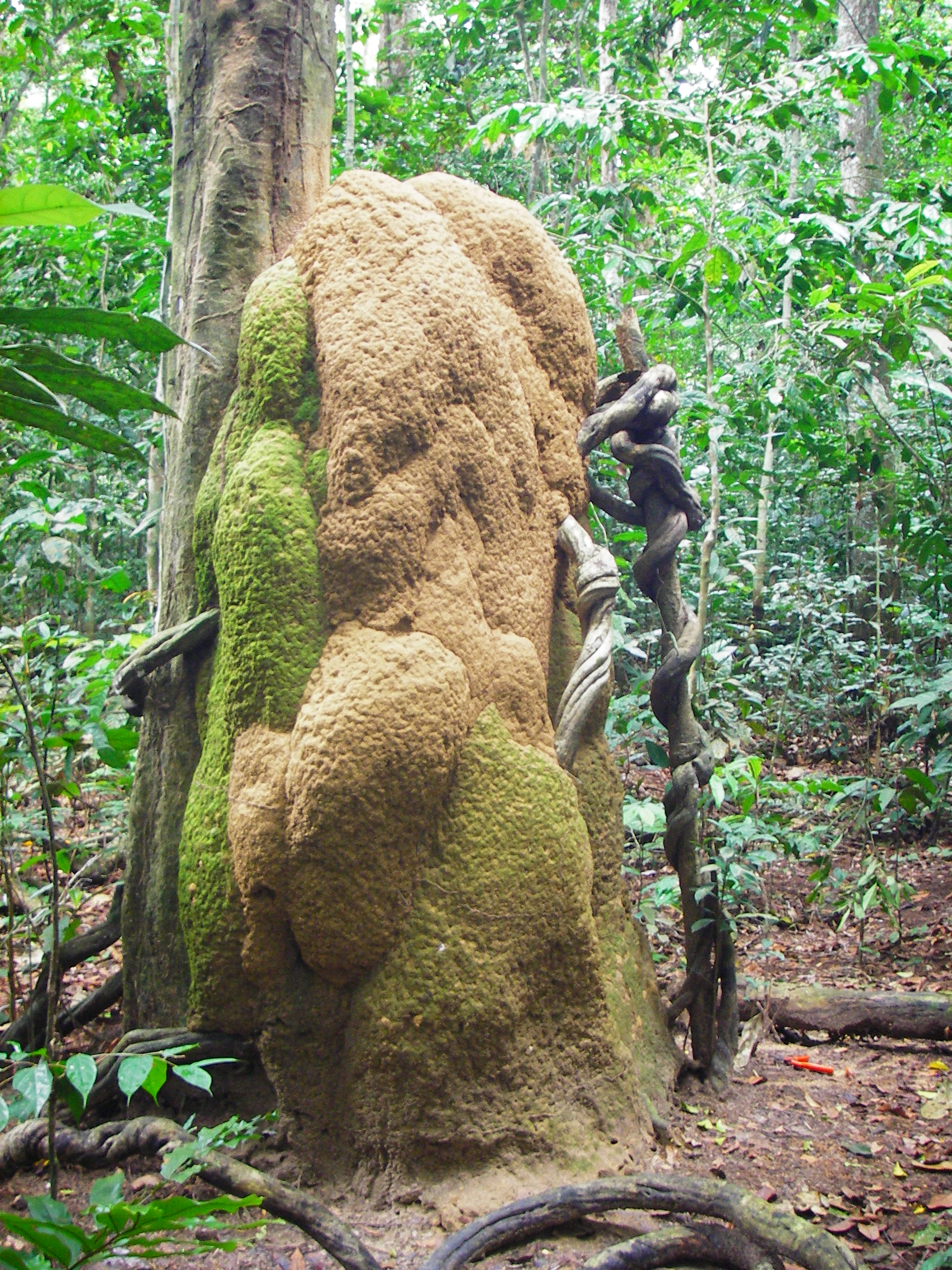|
<NOTE>
Published online (January 11, 2021)
Chimpanzees digging up termites: A problematic but persisting issue
William C. McGrew
School of Psychology and Neuroscience, University of St Andrews, Scotland, UK Every chimpanzee researcher knows of the value of our study species in modelling the evolutionary origins of humanity. As our nearest living relations, with a Last Common Ancestor about 7–8 mya, Pan is the sensible starting point for etho-archaeology, that is, linking their behavior and artefacts to hominins who provide the latter but not the former. The aim of this essay is to show that such modelling should be done with care, lest we go astray, even in the simplest ways. A case study exemplifies this cautionary note. This year marks the 20th anniversary of published findings inferring that Australopithecus (Paranthropus) robustus in South Africa used bone tools to dig into termite mounds in extractive foraging (Backwell & d'Errico 2001, d'Errico et al. 2001). Citing Goodall (Figure 1), the authors' conclusion was based on analyses of the use-wear patterns on the bones, that is, striations revealed by microscopy to have come from repeated abrasion with termite earth. They used experimental replicates of the artefacts to test their origin, by digging into extant termite mounds. Their conclusion was straight-forward: “Our results suggest that early hominids used a bone technology as a part of their dietary adaptations, and they maintained a bone tool termite-foraging cultural tradition in southern Africa for nearly a million years.” (Backwell & d'Errico 2001, p. 1362). 
So, how has this assertion fared over the last two decades? Eight years later, the authors modified their claims, based on further analysis, but still stuck to the termite extraction hypothesis: “Swartkrans and Drimolen tools may have been used to forage for termites, which remains the closest match, but also extract tubers, process fruits and conduct other, as yet unidentified tasks.” (d'Errico & Backwell 2009, p. 1772). Others also continue to restate the argument: Lesnik (2011) has done the most extensive and sophisticated experimental study of bone tools and termite foraging, comparing Macrotermes and Trinervitermes (see below). She concludes that the evidence for termite foraging is stronger than tuber-digging in the Swartkrans bone tools. Also, “South African weathered bone splinters used in unmodified form or occasionally shaped through grinding and implemented in foraging activities such as termite extraction.” (Pante et al. 2020, p. 2). These and other archaeological papers cite studies of chimpanzees using tools to get termites, so how apt is this linkage? Chimpanzees consuming termites via tool use has been known for over 50 years, since Goodall (1964) first described termite fishing. Since then scores of papers have shown it to be the prevalent form of ape extractive technology, found from Tanzania to Senegal. New studies continue to report it in more populations and with more behavioral diversity (Boesch et al. 2020). So, what is the problem with Backwell et al.'s analogy? First, wild chimpanzees have yet to be reported to use bone tools. Nor have captive chimpanzees, though some experiments have been done with other species in captivity, with mixed success. Second, chimpanzees have not been seen to dig up termite mounds, with or without tools. They are well-known to do more than simple fishing with flexible probes: Some use tool sets of a stout perforating/puncturing tool to access underground termite chambers, followed by prey extraction with a standard fishing probe (Sanz et al. 2004). But why is this activity not digging? If digging is defined as excavation, that is, displacing soil from the substrate, thus creating a cavity, then compressing soil by thrusting a stick into the ground is different (Estienne et al. 2017, Table 1, cf. McLennan et al. 2020, Table A). Third, Backwell and d'Errico chose Trinervitermes trinervoides for their experimental digging into termite mounds (d'Errico et al. 2001). I can find no confirmed record of this genus being eaten by chimpanzees, either with or without tools, or from observations or fecal analysis. The genus appears to be absent from at least nine sites of chimpanzee research (Bogart & Pruetz 2008, Table II). Trinervitermes is in a different sub-family (Nasutitermitinae) of Termitidae than is Macrotermes (Macrotermitinae), which is overwhelmingly the preferred choice of chimpanzees across Africa (e.g. Collins & McGrew 1985, Lesnik 2011). Trinervitermes is small-bodied and squirts noxious chemicals from its snout; Macrotermes has the largest body-size of all termite genera and tastes palatable (Figures 2 and 3). 

Fourth, carbon isotope data show that Paranthropus in South African had a diet of about 35% C4 foods (Sponheimer et al. 2005), while chimpanzees almost exclusively consume C3 foods, in both East and West Africa (Schoeninger et al. 1999, Sponheimer et al. 2006). Termite taxa vary greatly from pure C3 to C4 consumers, with the highest C4 values coming from harvester (grass-eating) termites, such as Trinervitermes (Sponheimer et al. 2005). Thus, on multiple grounds, Trinervitermes seems to have been an unfortunate choice for modelling. But how to explain the striated use-wear on the South African bone tools from antiquity, especially as the authors' original experimental replications indicate that it comes from digging termite earth? At least two alternative explanations are possible: (1) that the striations come from digging in a different but similar substrate, that is, a particular one in which soil particles are uniform in size and structure, as in the composition of termite mounds. (It seems likely that the size of such particles in mounds reflects the width of the gape of the mandibles of worker termites of any given species, but this idea seems not to have been tested.) Perhaps from digging up other dietary items in very sandy soil? Another alternative (2) is that the hominins did use bone tools to dig into termite mounds, but for another reason. Perhaps for geophagy, which does yield micro-nutrients, at least in Macrotermes (Seymour et al. 2014) but need not entail accompanying termitivory? In southern Africa, Macrotermes mounds show enrichment of multiple micro-nutrients compared with Trinervitermes, which show none (Mills et al. 2009). Neither of these alternatives has been investigated systematically for Pan, but chimpanzees do dig wells for drinking water in sandbars in riverbeds (McGrew et al. 2013), and chimpanzees (Reynolds et al. 2019) and humans (Hunter 1993) do consume termite earth, without digging, especially from Macrotermes. Wild chimpanzees do dig for other social insects, such as stingless honey-bees using tools (e.g. Estienne et al. 2017), as revealed by camera trap data that provide both the behavior and its products. Primate archaeological data from unhabituated chimpanzees suggest digging into the nests of army ants (Pascual-Garrido et al. 2013). But all such cases seem to be the result of using tools of vegetation, not bone. (No one seems to have recorded the availability of weathered bone as a potential raw material for chimpanzees in nature, but many chimpanzee field projects seem to accumulate a collection of such specimens in the process of research, especially at dry and open sites.) Captive chimpanzees will use tools to dig for food rewards buried by experimenters in contrived settings (e.g. Motes-Rodrigo et al. 2019), but their study made available only woody vegetation for use as tools to dig up fruits. The obvious actualistic experiment to be done might be to give captive chimpanzees a range of raw materials, including bone, horn core, and ivory, as potential tools to do their digging in various substrates, and then to subject the tools used to the same analyses employed by the archaeologists. Thus, the behavior could be matched to the use-wear. An even more comprehensive study also would involve the same raw materials applied to an experimental task involving vertical downward compression into the substrate. So, my conclusion, subject to correction by better-informed readers, is that the use of chimpanzees to model extinct hominin use of bone tools in termitivory was perhaps over-reaching, and that the topic merits further investigation. A lesson to primatologists is that such modelling of extinct hominids based on extant primates should be done carefully and precisely, that is, with focused etho-archaeology. A more general lesson is to tread carefully into cognate disciplines and to consult colleagues across disciplinary lines. I thank Susana Carvalho, Anthony Collins, Catherine Hobaiter, and Alejandra Pascual-Garrido for their assistance. REFERENCES Backwell LR, d'Errico F 2001. Evidence of termite foraging by Swartkrans early hominids. Proc Natl Acad Sci USA 98:1358–1363. https://doi.org/10.1073/pnas.98.4.1358 Boesch C, Kalan AK, Mundry R et al. 2020. Chimpanzee ethnography reveals unexpected cultural diversity. Nature Hum Behav 4:910–916. https://doi.org/10.1038/s41562-020-0890-1 Bogart SL, Pruetz JD 2008. Ecological context of savanna chimpanzees (Pan troglodytes verus) termite fishing at Fongoli, Senegal. Am J Primatol 70:606–612. https://doi.org/10.1002/ajp.20530 Collins DA, McGrew WC 1985. Chimpanzees (Pan troglodytes) choice of prey among termites (Macrotermitinae) in western Tanzania. Primates 26:375–389. https://doi.org/10.1007/BF02382454 d'Errico F, Backwell L 2009. Assessing the function of early hominin bone tools. J Archaeol Sci 36: 1764–1773. https://doi.org/10.1016/j.jas.2009.04.005 d'Errico F, Backwell LR, Berger, LR 2001. Bone tool use in termite foraging by early hominids and its impact on our understanding of early hominid behavior. S Afr J Sci 97:71–75. https://hdl.handle.net/10520/EJC97304 Estienne V, Stephens C, Boesch C 2017. Extraction of honey from underground bee nests by central African chimpanzees (Pan troglodytes troglodytes) in Loango National Park, Gabon: Techniques and individual differences. Am J Primatol 22672. https://doi.org/10.1002/ajp.22672 Goodall J 1964. Tool-using and aimed throwing in a community of wild chimpanzees. Nature 201:1264–1266. https://doi.org/10.1038/2011264a0 Hunter JM 1993. Macrotermes geophagy and pregnancy clays in southern Africa. J Cult Geograph 14: : 69–92. https://doi.org/10.1080/08873639309478381 Lesnik JJ 2011. Bone tool texture analysis and the role of termites in the diet of South African hominids. PaleoAnthropol 2011: 268–281. https://doi.org/10.4207/PA.2011.ART57 McGrew WC, Marchant LF, Payne CLR, Webster TH, Hunt KD 2013. Well-digging by Semliki chimpanzee: New data on laterality and possible significance of hydrology. Pan Afr News 20: 5–8. https://doi.org/10.5134/177625 McLennan MR, Rohen J, Satsias Z et al. 2020. Customary use of stick tools by chimpanzees in Bulindi, Uganda: Update and analysis of digging techniques from behavioural observations. Revue de Primatologie 10: 1–22. https://doi.org/10.4000/primatologie.6706 Mills AJ, Milewski A, Fey MV, Groengroeft A, Peterson A 2009. Fungus culturing, nutrient mining and geophagy: A geochemical investigation of Macrotermes and Trinervitermes in southern Africa. J Zool 278: 24–35. https://doi.org/10.1111/j.1469-7998.2008.00544.x Motes-Rodrigo A, Majlesi P, Pickering TR et al. 2019. Chimpanzee extractive foraging with excavating tools: Experimental modeling of the origins of human technology. PLoS One e0215644. https://doi.org/10.1371/journal.pone.0215644 Pante M, de la Torre I, d'Errico F, Njau J, Blumenschine R 2020. Bone tools from Beds II-IV, Olduvai Gorge, Tanzania, and implications for the origins and evolution of bone technology. J Hum Evol 148, published online. https://doi.org/10.1016/j.jhevol.2020.102885 Pascual-Garrido A, Umaru B, Allon O, Sommer, V 2013. Apes finding ants: Predator–prey dynamics in a chimpanzee habitat in Nigeria. J Hum Evol 75: 1231–1244. https://doi.org/10.1002/ajp.22187 Reynolds V, Pascual-Garrido A, Lloyd AW, Lyons P, Hobaiter C 2019. Possible mineral contributions to the diet and health of wild chimpanzees in three East African forests. Am J Primatol 81: e22978 https://doi.org/10.1002/ajp.22978 Sanz CM, Morgan DB, Gulick, S 2004. New insights into chimpanzees, tools, and termites from the Congo Basin. Am Nat 164: 567–581. https://doi.org/10.1086/424803 Schoeninger MJ, Moore J, Sept JM 1999. Subsistence strategies of two “savanna” chimpanzee populations: The stable isotope data. Am J Primatol 49: 297–314. https://doi.org/10.1002/(SICI)1098-2345(199912)49:4%3C297::AID-AJP2%3E3.0.CO;2-N Seymour CL, Milewski AV, Mills AJ et al. 2014. Do the large termite mounds of Macrotermes concentrated micronutrients in addition to macronutrients in nutrient-poor African savannas? Soil Biol Biochem 68: 95–105. https://doi.org/10.1016/j.soilbio.2013.09.022 Sponheimer M, Lee-Thorp J, de Ruiter D et al. 2005. Hominins, sedges, and termites: New carbon isotope data from the Sterkfontein valley and Kruger National Park. Hum Evol 48: 301–312. https://doi.org/10.1016/j.jhevol.2004.11.008 Sponheimer M, Loudon JE, Codron C et al. 2006. Do “savanna” chimpanzees consume C4 resources? Hum Evol 51: 128–133. https://doi.org/10.1016/j.jhevol.2006.02.002 Received: 16 November 2020 Accepted: 6 December 2020 Back to Contents |